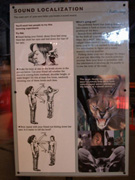


|
Sound & Hearing
|
Sound Localization
|
The bumps,
whorls and ridges of the pinnae—the fleshy outer part of the
human ears—filter sound differently depending on the height
of the sound source. Sound coming into the pinnae from an angle
above the head, for instance, is filtered differently from sound
coming from an angle below the head. This filtering effect works
best on sounds that have higher frequencies, or pitchies—like
these jiggling keys. To locate the horizontal direction of a sound
requires two ears, or binaural hearing. Sound coming from the right
or the left will reach one ear before the other. People use this
timing difference to find the direction of the sound source. Locating
a sound source in 3D space is a critical skill for many animals,
both in avoiding danger or finding food. To help find the height,
or vertical direction, of a sound source, most mammals, including
cats, rabbits and humans have large, fleshy outer ears. Barn owls,
which lack the elaborate pinnae of mammals, are nevertheless very
good at locating their squeaky rodent prey in the dark. To zero
in a sounds, the owls have asymmetrical ear openings: the left opening
is higher in the head than the right. With their lopsided ears,
owls use the difference in arrival times of a sound to locate both
the horizontal and vertical direction of the sound source.
|

|







|